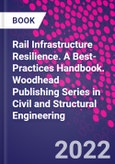Economic growth, security and sustainability across Europe are at risk due to ageing railway infrastructure systems. At present, the majority of such systems are aging and some have even reached their initial design lives. These issues align with a major challenge in civil engineering: how to restore and improve urban infrastructure and built environments. Policy, environmental and physical barriers must be addressed and overcome. The complex and interconnected nature of the problem means that there is a need for academia, industry, communities and governments to work collaboratively. The challenges posed by extreme events from natural and man-made disasters are urgent.
Rail Infrastructure Resilience: A Best-Practices Handbook presents developed improvement methods for rail infrastructure systems, toward resilience to extreme conditions. It shows how best to use new information in the engineering design, maintenance, construction and renewal of rail infrastructure resilience, through knowledge exchange and capability development. The book presents the outcome of a major European research project, known as the RISEN project. RISEN aimed to enhance knowledge creation and transfer using both international and intersectoral secondment mechanisms among European Advanced Rail Research Universities and SMEs, and Non-EU, leading rail universities, providing methodological approaches and practical tools for restoring and improving railway infrastructure systems for extreme events. Edited and written by members of this project, this book will be essential reading for researchers and practitioners hoping to find practical solutions to the challenges of rail infrastructure resilience.
Please Note: This is an On Demand product, delivery may take up to 11 working days after payment has been received.
Table of Contents
1. Introduction2. Railway vulnerability and resilience
3. Rail resilience to climate change; embedding climate adaptation within railway operations
4. Rail Transport Resilience to Demand Shocks and COVID-19
5. Management of railway stations exposed to a terrorist threat
6. Rail infrastructure systems and hazards
7. Wheel-rail dynamic interactions
8. Wheel/Rail Management under extreme conditions
9. Train-track interactions
10. Approaches for weigh-in-motion and wheel defect detection of railway vehicles
11. Advances in ground-borne vibration management
12. Lateral resistance of continuous welded rail tracks with different types of sleepers
13. Diagnostics and management methods for sleepers
14. Maintenance strategies for rail ballast and formation
15. Inspection technologies for railway tracks
16. Risk-based Maintenance of Turnout systems
17. Railway Bridge under increased traffic demands
18. Structural health monitoring strategy for novelty detection in railway bridges using traffic induced dynamic responses
19. Improved dynamic resilience of railway bridges using external dampers
20. Monitoring and management of OHLE
21. Overhead Conductors








